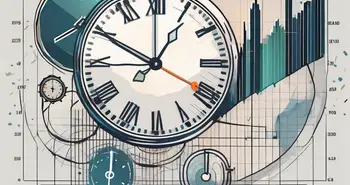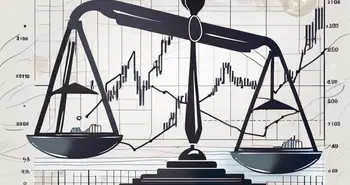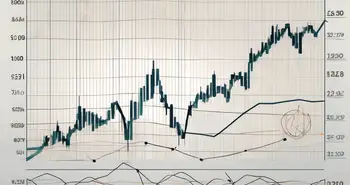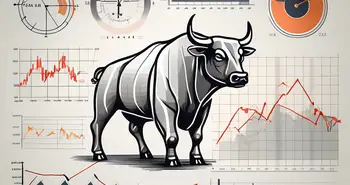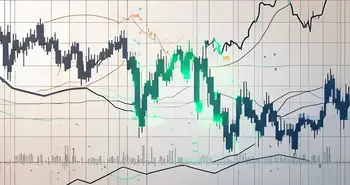Different Time Frames in Forex Trading

Forex trading is a dynamic and exciting market, offering ample opportunities for profit. However, to navigate this complex landscape successfully, one key aspect that traders must understand is time frames. In this comprehensive guide, we will delve into the concept of time frames in forex trading, explore the different types of time frames available, discuss how to choose the right time frame for your trading style, and highlight the advantages and disadvantages of each time frame.
Understanding the Concept of Time Frames in Forex Trading
Time frames refer to the duration of a specific chart, displaying the price movement of a currency pair. They range from the shortest time frames, such as minutes or ticks, to longer-term time frames, such as days, weeks, or even months. Each time frame offers a unique perspective on the market, allowing traders to analyze price patterns and make informed trading decisions.
Definition of Time Frames in Forex Trading
In forex trading, time frames are represented by candlestick or bar charts, which display the opening, closing, high, and low prices of a currency pair within a specific time period. Different time frames can provide traders with varying insights into price action and help identify trends, reversals, and support and resistance levels.
Importance of Time Frames in Forex Trading
The choice of time frame is crucial as it greatly influences trading strategies and the ability to identify favorable trade setups. By analyzing multiple time frames, traders can gain a comprehensive understanding of a currency pair's price behavior and make more accurate predictions. Moreover, time frames enhance risk management by providing valuable information on potential entry and exit points.
Types of Time Frames in Forex Trading
Forex trading offers three main categories of time frames: short-term, medium-term, and long-term. Let's explore each type in detail:
Short-Term Time Frames
Short-term time frames, such as 1-minute, 5-minute, and 15-minute charts, are favored by day traders and scalpers. These charts provide a detailed view of price action, allowing traders to capitalize on short-lived fluctuations and small price movements. However, they require constant monitoring and a disciplined approach.
Medium-Term Time Frames
Medium-term time frames, such as 1-hour, 4-hour, and daily charts, cater to swing traders who aim to capture multi-day or week-long trends. These charts offer a balance between detailed price analysis and a broader view of the market. Swing traders can capitalize on prevailing market trends and avoid getting caught in short-term noise.
Long-Term Time Frames
Long-term time frames, such as weekly and monthly charts, are ideal for position traders who hold positions for months or even years. These charts provide a broader perspective on price movements, helping traders identify long-term trends and major support and resistance levels. Position traders focus on fundamental analysis and take a patient approach, waiting for high-probability setups to materialize.
Choosing the Right Time Frame for Your Trading Style
Selecting the appropriate time frame requires aligning it with your trading style, goals, and available time commitment. Let's explore the time frame choices for different trading styles:
Scalping and Day Trading Time Frames
For scalpers and day traders, short-term time frames, such as 1-minute or 5-minute charts, offer the necessary velocity and precision to capture quick profits from rapid price movements. These traders often utilize technical indicators and employ tight stop-loss orders to manage risk effectively.
Swing Trading Time Frames
Swing traders, focusing on capturing medium-term trends, find 1-hour, 4-hour, or daily charts most suitable. These time frames allow them to identify potential trend reversals and ride extended price moves, maximizing profit potential while maintaining a moderate level of intraday trading activity.
Position Trading Time Frames
Position traders, concerned with long-term trends and macroeconomic factors, rely on weekly or monthly charts. These time frames provide a comprehensive overview of price patterns and are suitable for traders with a patient and long-term approach. Position traders typically examine fundamental factors, such as economic indicators and central bank policies, to make informed trading decisions.
As an expert in forex trading, I highly recommend aligning your time frame choice with your trading style and risk tolerance. It's crucial to focus on time frames that suit your personality and trading goals while considering the potential time commitment required.
When I first started my forex trading journey, I experimented with different time frames to find the perfect fit for my trading style. After months of trial and error, I realized that I was naturally inclined towards swing trading. The 4-hour charts allowed me to capture substantial price moves while still providing enough time to analyze the market and manage my trades effectively. Finding this alignment significantly improved my trading results and confidence.
Advantages and Disadvantages of Different Time Frames
Each time frame has its own set of advantages and disadvantages. Let's examine the pros and cons of each time frame type:
Pros and Cons of Short-Term Time Frames
Short-term time frames offer the advantage of quick decision-making and the potential for fast profits. However, they also come with the risk of increased market noise, false signals, and a higher probability of being stopped out due to volatility. Experience, precision, and efficient risk management are essential for success in this fast-paced trading environment.
Pros and Cons of Medium-Term Time Frames
Medium-term time frames provide a balanced approach, allowing traders to capture substantial price moves while avoiding excessive intraday trading stress. However, they require patience and discipline to hold trades for extended periods and withstand temporary market fluctuations. Swing traders should also be mindful of news events that can influence medium-term trends.
Pros and Cons of Long-Term Time Frames
Long-term time frames offer the advantage of significant profit potential by capturing major trends. Position traders benefit from reduced market noise and the ability to weather short-term volatility. However, long-term trading requires a high level of patience, as positions may take months or years to unfold. Furthermore, staying updated with fundamental factors is crucial to maintain a well-informed trading approach.
FAQ
What are time frames in forex trading?
Time frames in forex trading refer to the duration of a specific chart that displays the price movement of a currency pair within a specified time period. Traders use different time frames to analyze price patterns and identify trading opportunities.
Which time frame should I choose?
The choice of time frame depends on your trading style, goals, and available time commitment. Scalpers and day traders prefer short-term time frames, while swing traders focus on medium-term time frames. Position traders favor long-term time frames.
Can I use multiple time frames in my analysis?
Absolutely! Analyzing multiple time frames can provide a comprehensive view of the market and enhance the accuracy of your trading decisions. Traders often combine short-term, medium-term, and long-term time frames to capture various aspects of price action.
What are the advantages of using different time frames?
Using different time frames allows traders to identify short-term trends within longer-term trends, potential reversal points, and crucial support and resistance levels. It helps to get a broader perspective on price movements and make more informed trading decisions.
What is the importance of choosing the right time frame?
Choosing the right time frame is crucial as it aligns your trading approach with your trading style, goals, and risk tolerance. It provides a framework for analyzing price action and identifying high-probability trade setups, enhancing your chances of success in forex trading.
Now that you're well-versed in the concept of time frames in forex trading and the different types available, you can confidently choose the time frame that suits your trading style. Remember, finding the right time frame is a crucial aspect of becoming a successful forex trader. Happy trading!
Ready to take your forex trading to the next level with the right time frame? Discover the future of trading with Morpher, the innovative platform that offers zero fees, infinite liquidity, and the flexibility of fractional investing. Whether you're a day trader, swing trader, or position trader, Morpher's unique trading experience on the Ethereum Blockchain caters to all styles. Sign up now to experience the power of 10x leverage and secure your funds with the Morpher Wallet. Don't miss out on this transformative trading journey. Sign Up and Get Your Free Sign Up Bonus today and join the community of traders who are already shaping the future of investing.

Disclaimer: All investments involve risk, and the past performance of a security, industry, sector, market, financial product, trading strategy, or individual’s trading does not guarantee future results or returns. Investors are fully responsible for any investment decisions they make. Such decisions should be based solely on an evaluation of their financial circumstances, investment objectives, risk tolerance, and liquidity needs. This post does not constitute investment advice.

Painless trading for everyone
Hundreds of markets all in one place - Apple, Bitcoin, Gold, Watches, NFTs, Sneakers and so much more.

Painless trading for everyone
Hundreds of markets all in one place - Apple, Bitcoin, Gold, Watches, NFTs, Sneakers and so much more.

